#construct tutorials
Text
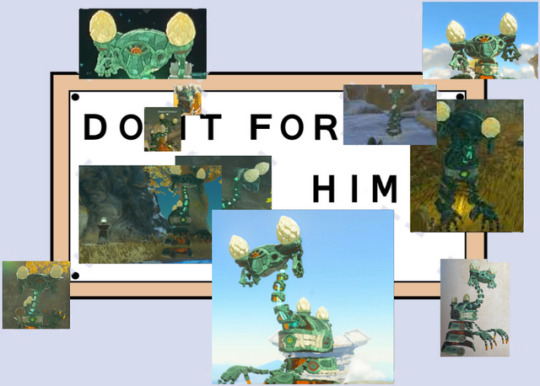
H I M
#tears of the kingdom#totk#sentinel construct#my beloved#new blorbo alert#new hyperfixation just dropped#I'm not even out of the tutorial area yet aldnofaidhohf
2K notes
·
View notes
Text
Thoughts and observations on universal calligraphy applied on neography.
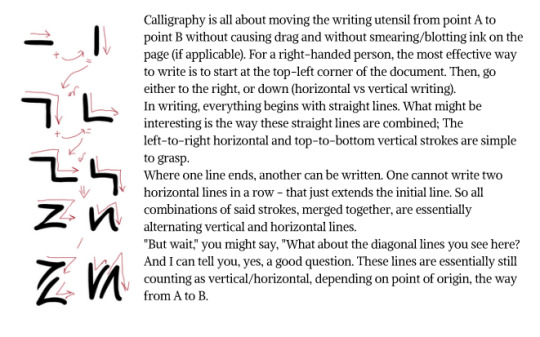





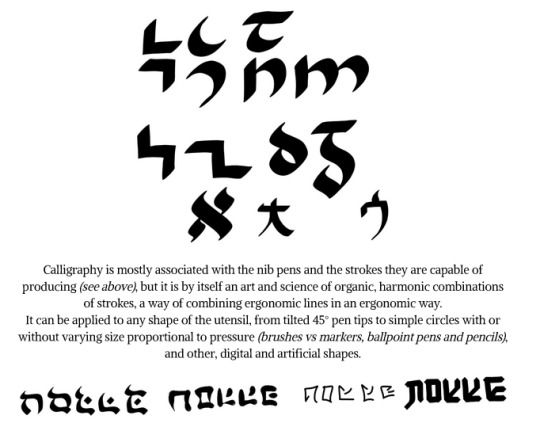

#conlangcrab#conlanging#conlang#constructed language#conlangcrab talks#linguistics#neography#calligraphy tutorial#calligraphy#conscript#art ref#art tutorial#thecrazyneographist
213 notes
·
View notes
Text
How to Foreshorten Hands References & Tutorial


#523#524#foreshortening#hands#hands reference#ref#references#reference#construction#tip#art tips#art tutorial#art tip#art tutorials#drawing#drawing tip#drawing tips#drawing tutorial#drawing tutorials#art
358 notes
·
View notes
Text
Alright I have now actually been working in a bank for a while and I gotta say,,,,,, it kiiiiiinda takes the drama out of Leverage.
Like. Do you know how easy it would be to rob us? Currently the only alarm that requires a code has been permanently disabled for over a month due to construction on the upper floors. The key cards that let you access the vault are given to the tellers- aka the college kids who let just about anyone in if they ask. Hell, I've given spare keycards to employees I didn't even recognise because I'm bad with faces and didn't want to be rude, they were wearing the company color so I just said sure here you go. There's just physical keys lying around everywhere. We also technically have a vault inside the vault that only head tellers can access, but I have never seen it closed.
Like. Robbing us wouldn't take an episode, it wouldn't even take a whole scene. Parker would be downright offended if she came to rob us. She wouldn't even have to crawl through any air vents, pick any locks, anything- literally just wear blue and ask politely to be let into the vault.
We would disappoint Parker so bad
#also none of us have changed our passwords in months#and anyone who just says theyre IT can access p much anything#honestly with the construction crew in the building we're just asking to be robbed#we got people in here 24/7 and no alarms#and the panic buttons get accidentally hit so often i don't think they'd even work#anyway enjoy this tutorial on how to rob [REDACTED] bank#leverage#parker leverage#our only saving grace is we usually only have like 1mil or less cash at any guven time#but still
40 notes
·
View notes
Text
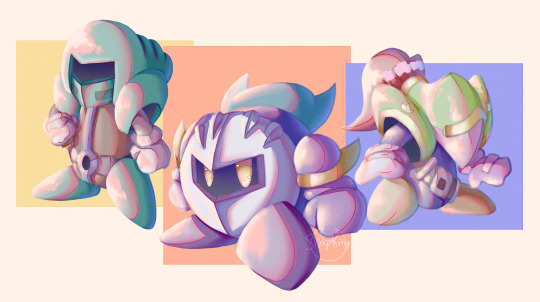
Still pretty burnt out from Art Fight, but I've been checking out different tutorials on how to improve my art in the meanwhile and stumbled upon some digital painting/rendering videos- and seeing as how the two in particular I watched during this were only 6 minutes each I actually had the attention span to follow along and absorb the tips LMAO.
//I don't really know how to paint/render, I normally do cell-shading and even that's a tad limited hhh. I should probably focus on the basics after this because whew this is rough. But it was very fun overall, I'd love to try this technique out again sometime!
If anyone's interested in the tutorials I followed, both videos are here and here on YouTube by nastume__san.
#kirby#kirby right back at ya#kirby of the stars#hoshi no kaabii#meta knight#kirby anime#blade knight#sword knight#They're my comfort characters your honor#Finally learned how to draw Blade's armor LMAO#if anyone has any tips or tutorials they think would be helpful I'd be more than appreciative#constructive criticism as well <3
114 notes
·
View notes
Text
I SUMMON THEE TROLLS FANDOM
Does anyone have higher res pictures of the Brozone album covers that's preferably front-facing I'm working on creating it irl for my wall

#trolls band together#trolls 3#dreamworks trolls#trolls dreamworks#trolls brozone#trolls movie#im using a cardboard square i got from a calender !#and construction paper....its simple so i think if you can find the album cover you can ALSO make it#or i could make a haphazardly slapped together tutorial lol
34 notes
·
View notes
Text
Introduction to Collective Seraphic
Now that Seraphic's at a stable place, I think I'm gonna take some time to delve into the basics of how it operates. For this post I'll only be going into the language itself and not the writing system, as that's going to need a post of its own to elaborate on. I'll try to keep this as concise as possible, but I may make separate posts expanding on topics discussed in this one. So, without further ado, onto the infodump!
Background
Collective Seraphic (which I'll be referring to as "Seraphic") is an artlang that I've created for a comic that as of this post I have not began yet, but am still developing. The majority of the comic will take place on the Seraph Homeworld, an alien planet some 3,000 lightyears from Earth populated by the seraph species (pictured below):

Within the story, Seraphic acts as the lingua franca of the Seraph Homeworld and the many colonized planets under Seraph control. It's used in the government, and among speakers of differing languages. As such, this language was the first one that I knew I would need to make as it will play a vital role in both the storytelling and narrative structure.
Syntax
Seraphic is largely a fusional language, employing affixes to modify the semantic role and meaning of morphemes. Seraphic does not, in the traditional sense, have verbs, so the sentence structure is strictly subject-object (will expand upon later). Nouns decline for number and tense, and are grouped into seven noun classes. Adjectives agree with nouns in number, except if derived from nouns themselves, in which case they'll also agree in class. Seraphic is very head-initial; with demonstratives, numerals, possesives, adjectives, genitives, and relative clauses following the noun the modify; and prepositions preceeding the nouns they modify. Auxiliaries preceed procedurals (again, will expand upon later).
Phonology
Here is the phonological chart for Seraphic:
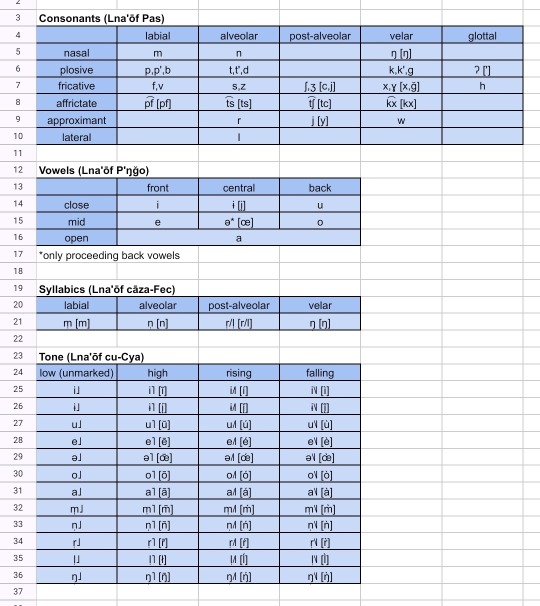
It has a syllable structure of (CC)V(CC). Plosives cannot exist word finally, clusters of consonants of the same manner are illegal, and vowel clusters are also not permitted. Syllabic consonants are grouped with vowels and behave much like them, carrying tone and stress, so they together are grouped and referred to as vocalics. Seraphic is a tonal language, employing the use of four tones: rising (á), falling (à), high (ā), and low (a). Low tones remained unmarked in both the Seraphic script and in romanization. Stress is syllable-independant. It will take either the ultimate, penultimate, or rarely the antepenultimate. Stress always falls on the syllable with a voiceless initial obstruent nearest to the end of the word. If none are available, it will fall on the syllable with an initial sonorant within the same parameters. Stress will never fall on a voiced obstruent. For clarity, I'll provide a key describing the pronunciation of the romanization.
Sounds that are similarly pronounced as they're read in American English:
m, n, p, b, t, d, k, g, f, v, s, z, y, w, l
Sounds that have special pronunciations:
ŋ, like the ng in English "sing"
p', like the ጴ in Amharic "ጴጥሮስ"
t', like the t' in Navajo "yá'át'ééh"
k', like the კ in Georgian "კაბა"
', like the the space within English "uh-oh"
c, like the sh in English "sharp"
j, like the s in English "measure"
x, like the gh in English "ugh"
ğ, like the γ in Greek "γάλα"
pf, like the pf in German "Pfirsiche"
ts, like the z in Italian "grazia"
tc, like the ch in English "chain"
kx, like the kh in Lakota "lakhóta"
r, like the rr in Spanish "perro", although occasionally like the r in Spanish "amarillo"
i, like the ee in English "meet"
į, like the ы in Russian "ты"
u, like the oo in English "boot"
e, like the é in French "beauté"
œ, like the a in English "Tina"
o, like the o in Classical Latin "sol"
a, like the a in English "bra" although this can change to be more forward or more backward.
Another letter that might trip people up is ł, which is meant to represent the high tone syllabic 'l'. Otherwise, syllabics are written the same as their pulmonic counterparts, with tone markers written when applicable.
Nouns
Nouns make up the bulk of the Seraphic lexicon. Every noun is grouped into one of seven classes:
Solar class: nouns related to seraphim or seraph-like beings, and seraph body parts. Prefix appears as zā-, zō-, zē-, s-, or ts-.
sēr = "person"
Astral class: nouns related to non-seraph animate lifeforms (their equivalent to "animals"). Prefix appears as ğr-, x, or kx-.
xuc = "cherub"
Vital class: nouns related to inanimate lifeforms (their equivalent to "plants"). Prefix appears as wā-, wō, w-, ū-, wē-, or wī-.
wējlux = "tree"
Terranean class: nouns related to landscapes, locations, and natural phenomena. Prefix appears as va-, vo-, vu-, f-, and pf-.
voxāl = "sun"
Metallic class: nouns related to inanimate objects, both natural and artificial. Prefix appears as ja-, jo-, c-, or tc-.
jağrú = "rock"
Lunar class: nouns related to abstract concepts, and terms related to time. Prefix appears as la-, lo-, le-, li-, y-, or l/ł-.
levren = "job"
Oceanic class: nouns related to general words, tangible concepts, numbers, all adjectives, and non-incorporated loanwords. Prefix appears as a/ā-, o/ō-, or aw-.
awuf = "group"
Adjectives do not agree in class, due to the fact that nouns originally are derived from adjectives, and noun classes acted as a way to differentiate between nouns and adjectives.
fa = "warm, hot"
jafa = "fire" (lit. "a hot thing")
When adjectives are used as predicatives, they decline into the oceanic class in order to take the procedurals (once more, will expand upon later).
Nouns also decline for four numbers: singular (one thing, usually unmarked), dual (two things, both things; suffixes as -ac, -oc, -œc, or -c), plural (things, many thing; suffixes as -n, -an, or -in), and collective (every thing, all things; suffixes as -āf/ōf, -áf/-óf, or -'ōf).
Seraphic doesn't use pronouns. Everything and everyone is referred to by name, including yourself. From our perspective, the Seraphic language constantly speaks in the third person. However, it can be repetitive to use the same name over and over again in a sentence, and sometimes you don't know the name of things, so they'll apply what I've called pro-forms. They consist of the demonstrative adjectives fl "this", sl "that", and xl "yon" declined into the Solar class and taking the place of the first, second, and third person respectively. For ease of reference, I'll provide the forms and their declensions below.
zāfl (I/me), zāflc (both of us), zāvlin (we/us), zāfláf (all of us)
zāsl (you), zāslc (both of you), zāzlin (you guys), zāsláf (all of you)
zōxl (they), zōxlc (both of them), zōğlin (many of them), zōxláf (all of them)
Seraphic makes no distinction in the gender of the speaker, in this regard. Although these resemble pronouns, they're not meant to be used as often as regular pronouns, and whenever possible it's much preferred that you refer to someone or something by name.
Adjectives and Prepositions
Adjectives are fairly straightforward. Adjectives follow the noun they modify (e.g. sēr tan "big person"), and agree with them in number (e.g. sēr tan "big person" vs sērn t'aŋon "big people"). Adjectives agree in the singular form with singular and collective nouns, and they agree in the plural form with dual and plural nouns.
There are three main types of adjectives: native adjectives (e.g. cna "good"), borrowed adjectives (e.g. anzn "nice"), and noun-derived adjectives (e.g. arfi/ofi "new"). Native and borrowed adjectives don't agree with noun classes, but noun-derived adjectives do. It originated from the animacy-based adjective agreement system in Proto-Seraphic, which has been lost in all other adjective instances. When you want to make a noun into an adjective you'll affix one of two prefixes to it: ar- (if agreeing with Solar, Astral, and Vital nouns) and o- (if agreeing with Terranean, Metallic, Lunar, and Oceanic nouns). There are specific rules on the forms each prefix takes based on the noun they're attached to:
"ār-" when preceeding high or falling vocalic syllables (e.g. sēr ārzājna "popular person")
"ar-" when preceeding low or rising vocalic syllables (e.g. wēn arfe "local fruit")
"ó-" when preceeding high or falling vocalic syllables (e.g. lalel ówē "grassy flavor")
"o-" when preceeding low or falling vocalic syllables (e.g. lesar olvulvren "economic problem")
"ōw-" when preceeding words that start with a vocalic (e.g. lnin ōwāsāvbas "momentary event")
Prepositions occur before the nouns they modify, and don't change form in any circumstance. There are currently 19 prepositions in the modern language, and they are usually connected to nouns via a hyphen (e.g. e-fe "at (the) place"):
cu = of; indicates possession
pr̄ = indicates the indirect object, equivalent to "to" in the phrase "The man sends the letter to me."
in/īn = as or like; indicates similarity or resemblance. Will either be low or high tone depending on the tone of the following syllable.
e/ē = at or on; indicates location.
tsa = near or for; indicates relative distance from a location or an action performed for the sake of the referent.
cni = without; indicates a lack of possession or company.
wa = in or inside of; indicates interior position.
tn = on top of, above, or before; indicates superior position or a prior instance in time.
pux = under, beneath, or after; indicates inferior position or a following instance in time.
pi = with, together with; indicates being in company of or making use of the referent.
fān = from or away from; indicates the motion of leaving the referent.
ku = out of; indicates motion from within the referent towards the exterior.
tun = into or through; indicates motion from outside the referent towards the interior.
xel = to or towards; indicates the motion of approaching the referent.
kxun = across; indicates motion from one location to another
pn̄ = around; indicates location surrounding the referrent.
cāza = between; indicates location in the middle of the referrent.
tē = after, behind; indicates posterior position.
fr = during; indicates a moment in time
Prepositions aren't combined in Collective Seraphic, but may be in certain instances in colloquial speech.
Procedurals
Okay, this is probably the most complicated part of Seraphic, so I'm going to need to get into things individually. First, I'll start with defining a procedural itself. Procedurals are the term I use for the prefixes used to describe the relationship or process of and between the agent noun and the patient noun. These are what act as the equivalent to "verbs" in earth languages. There are three in use:
Existential: used to denote a state of being or equivalence between agent and patient, or to the patient and itself. Equivalent to English "to be" (e.g. A is B, there is B). Usually prefixes as some variant of n-, m-, or ŋ-.
Actional: used to denote an action or process between the agent and patient, or with the patient and itself. Equivalent to English "to do" or "to act upon" (e.g. A acts upon B). Carries a connotation of agency and intent. Usually prefixes as some variant of re-, ra-, or r-.
Resultative: used to denote an occurence or change in state between agent and patient, or patient and itself. Equivalent to English "to become", "to happen", or "to change into" (e.g. A becomes B, B happens to A). Carries a connotation of passiveness or motion. Usually prefixes as some varient of ed- or ez-.
The procedural will change its form slightly depending on the class and declension pattern of the noun it modifies. It always affixes to the patient noun, demonstrating a relationship of an action and what is being acted upon. In this way, the patient can be clearly identified. In transitive or causative clauses, the word order is always S(P)O, with the agent acting as the subject and the patient as the object. In intransitive and passive clauses, the word order is always (P)S, with the patient acting as the subject and the agent demoted to the indirect object or omitted entirely.
Although seemingly limiting, using these three procedural, as well as prepositions, nouns, and adjectives, altogether can be used to make all sorts of verb equivalents that are called "procedural phrases". I'll demonstrate how to build a sentence now. First thing we need to know is the subject and object:
Sāx ... jafa (The child ... the fire)
Next, I'll add the actional procedural in the present tense to this.
Sāx rejafa (The child acts upon the fire)
By itself this is technically grammatically correct, but it doesn't really mean anything. It's too broad. So we add a prepositional phrase to specify exactly what action the child is taking towards the fire.
Sāx pi-sīman rejafa (The childs acts upon the fire with (their) eyes)
Now we know that the child is performing an action involving the use of their eyes. Now of course this could mean many different things in English, but in Seraphic the first thing that comes to mind would be fairly obvious: to see! Thus, "Sāx pi-sīman rejafa" would be the same as saying "The child sees the fire" in English! There are a lot of set phrases that equate to verbs, and remain consistent in their arrangement. Often differing phrases are a useful way to ascertain where someone is from or what their first language is.
Tense and Aspect
Seraphic has six main tenses: two pasts, two presents, and two futures. The two pasts consist of the recent past (happening recently) and the remote past (happening a long time ago), and they prefix and/or combine with the procedural.
Sāx pi-sīman ğrejafa (The child just saw the fire)
Sāx pi-sīman eğrejafa (The child saw the fire a while ago)
Similarly, the future tenses consist of the near future (will happen soon) and the distant future (will happen eventually).
Sāx pi-sīman drejafa (The child will soon see the fire)
Sāx pi-sīman izrejafa (The child will eventually see the fire)
The present tenses consist of a general present tense (happens) and the infinitive (to happen) which is used with auxiliaries and copulae and carries no presence in time.
Sāx pi-sīman rejafa (The child sees the fire)
Pi-sīman ezrejafa (To see a fire)
Whether someone considers an event to be nearer or farther in time from them is completely up to their discretion. There's no set timeframe for when to use the recent vs. remote past, it's all fairly subjective. However, whether you decide to use the recent or remote can really indicate whether you believe something to be in the distant past or future, or just a few moments ago or soon.
Seraphic also makes use of two copulae, the perfective -r and the imperfective -l, helping clitics that expand on the aspect of the procedural, i.e. how the procedural happens over time instead of when in time. The copulae are separate from the procedural, being placed directly before it and conjugating on their own similarly to the lexical procedural. When the copulae are in use, they are conjugated instead of the lexical procedural, while the lexical will be put into the infinitive. The exception to this is if the point in time is considered necessary to be stated for the sake of clarity or emphasis, in which case the lexical verb will also conjugate (though this isn't considered to be the default). The two copulae each conjugate to six tenses, and give 12 individual aspects in total. They are as follows, starting with the perfective:
āgxōnr - Pluperfect: indicates that the action happened at a point before some time in the past either specified or implied (e.g. āgxōnr nidsl "that has happened")
xōnr - Preterite: indicates that the action happened in the past with no reference to if it was completed recently or remotely. A general past (e.g. xōnr nidsl "that happened")
nar - Relative: indicates relative clauses, i.e. clauses that act to modify a noun similarly to an adjective. Equivalent to "that", "who", or "which" (e.g. lsl nar nidsl "the thing that happens")
ednr - Gnomic: indicates general truths, common knowledge, and aphorisms (e.g. ednr nezłsl "things happen")
t'enr - Future Simple: indicates the action will happen in the future with no regard to how near or far it is from the present (e.g. t'enr nidsl "that will happen")
āt'ēnr - Future Perfect: indicates that the action will happen before a time or event in the future (e.g. āt'ēnr nidsl "that will have happened")
And the imperfective:
ŋ̄xōzl - Discontinuous: indicates that an action was happening in the past, but is no longer happening in the present (e.g. ŋ̄xōzl nidsl "that used to happen")
xōzl - Habitual: indicates that an action is done often or out of habit (e.g. xōzl nidsl "that always happens")
īzl - Progressive: indicates that an action is happening at the very moment of conversation (e.g. īzl nidsl "that is happening")
nizl - Prospective: indicates that an action will be starting to, or is in the process of happening (e.g. nizl nidsl "that is about to happen")
t'ezl - Iterative: indicates that an action happens again, repeatedly, or more than one time based on context (e.g. t'ezl nidsl "that happens again" or "that happens again and again")
nt'ezl - Continuative: indicates that an action happens continuously and without end (e.g. nt'ezl nidsl "that still happens")
With both tense and aspects, this largely expands the capability of Seraphic in referring to time.
Moods
Seraphic makes use of seven modal particles to denote seven moods. They are always placed at the beginning of clauses, and no two modal particles can exist in the same clause. They are grouped into four categories: the declaritive (indicative and negative), the inferential (evidential and interrogative), the deontic (volitive and imperative), and the epistemic (subjunctive and conditional). They add extra clarity in the speakers mood or opinion concerning the clause they modify, and are as follows:
Indicative: base form of a clause. Indicates that the speaker is stating a fact or what exists, and is unmarked (e.g. idsl "that happens")
tu - Negative: indicates that the speaker is stating a fact that is untrue or what doesn't exist. Usually only appears in formal, official texts, as the first syllable of the procedural will chage tone to contrast as well and leaves the particle unneccesary in colloquial speech (e.g. tu īdsl "that doesn't happen")
cuc - Evidential: indicates that the speaker is stating a fact that they believe or understand to be true, regardless of having experienced it or not. (e.g. cuc idsl "apparently that happens") Direct evidentiality is denoted using a different method.
an/ān - Interrogative: indicates that the speaker is confirming whether a statement is or isn't true. Forms questions (e.g. an idsl? "does that happen?")
tcān - Volitive: indicates that the speaker desires for the statement to be true (e.g. tcān idsl "that wants to happen" or "that needs to happen" or "that should happen")
má - Imperative: indicates that the speaker is giving a command or suggestion, to themselves and/or to other referents. Functions additionally as a cohortative and a jussive (e.g. má idsl! "let that happen!")
tir - Subjunctive: indicates that the speaker believes the statement to be possible or likely (e.g. tir idsl "that could/would/might happen")
nun - Conditional: indicates that speaker believes the statement to be possible under specific circumstances or conditions (nun idsl "if/when that happens..."
Miscellaneous
That's about the basics of the Seraphic language outline. I'd like to eventually get into things like comparison, evidentiality, declension forms and the like, but those are all topics that definitely need their own individual posts. Real quick, I want to provide one more additional fact about Seraphic.
Seraphic uses base-16, meaning it groups numbers in sets of 16 instead of sets of 10 like we do. 1-16 would be written 1, 2, 3, 4, 5, 6, 7, 8, 9, A, B, C, D, E, F, 10. 10 would be read as 16, and equally 20 would be 32. They're still counting the same amount of things, they're just dividing it up differently!
Anyways that's about it, I hope to share more about Seraphic soon, and when the comic gets released I hope you'll all be able to read it and pick out the many many lines of Seraphic I've poured into it!
ŋKowīci cu-stux 'ōf tsa-levp'ā cu-zāsláf pi-lizt'n ğōdjasa! (Thank you all so much for reading!)
#conlang#constructed language#artlang#grammar#phonology#syntax#linguistics#seraphic#collective seraphic#info post#hope i didn't make a fool of myself in front of the whole community#accidentally showed the world i dont know shit abt linguistics gotdamn#im sure itll be fine#writing system tutorial forthcoming
19 notes
·
View notes
Note
Had a costume construction question. I've noticed that in fittings for and construction of Howard's skirt (and I believe Boleyn, but I may be confusing it for something else entirely), the waistband appears to be, what I think is, cotton webbing. Do you know what material it is? If you do, is this what the vinyl is placed on top of or is it replaced by the vinyl?
It’s interfacing! It’s a material that’s used on the inside of many clothes (among other projects) to add more shape and stability as needed. You’ll often find it in necklines or waistbands to help them lay flat and maintain shape/quality as areas with a lot of stress out on them. Definitely necessary to include when making Six cosplays. There are some different types in terms of application and weight; the type that's best to use will be dependent on what materials you're using for your cosplay. For more information on all that, there’s this really good post, and if you have further questions about a specific costume/cosplay or material you can always send me another ask or DM @sixcostumerefs.
It should be used in your actual cosplay, between your lining material and your external materials. So if you’re working on Howard, your waistband from inner to outer layers should be lining->interfacing->externally facing base*->velcro for closure where required->pink vinyl. Your skirt would be lining->interfacing with boning->buckram**->pink vinyl->cutouts panel.
*Six has started using a black for that base, but they’ve just used more pink vinyl in the past:

(Look at the skirt closures/mic holsters - Abigail Sparrow’s Breakaway 3.0 skirt was pink all around, while Aline Mayagoitia has a plain black base between the closure and mic holster)
**Buckram is a stiffened fabric used to give more shape and structure. Very often used in theatre and dance costumes and is one of my favorite materials to work with. More info here. It's very necessary for Aragon, Boleyn, and Howard skirts and is a big part of what helps them keep their shape. For best use it should go between the boning layer and vinyl layer(s), like I spelled out above for Howard.
#six the musical#six cosplay#tutorial#six cosplay refs#six materials#six costumes#six musical#six howard 2.0#katherine howard six#six construction
19 notes
·
View notes
Text
Can You Learn to Sew Online? A Comprehensive Look at Your Options with ONSA
At ONSA - Online Sewing Academy, the world of stitching and garment construction should be accessible to everyone, regardless of location or schedule. In today's digital age, online learning has revolutionized how we acquire new skills, making it possible to master intricate crafts like sewing from the comfort of our homes. But can you truly become an expert stitcher through virtual classes alone? Let's explore the options available and how ONSA empowers you to embark on an enriching sewing journey.
The Beauty of Pre-Recorded Video Lessons
Ah, the world of pre-recorded tutorials - a treasure trove of knowledge at your fingertips! ONSA's extensive library of meticulously crafted video lessons offers a comprehensive exploration of sewing techniques, from the fundamentals of threading a needle to the intricacies of advanced garment construction. One of the most significant advantages of this format is the ability to learn at your own pace, rewinding and revisiting lessons as many times as needed until each stitch and seam becomes second nature.
Our pre-recorded videos are thoughtfully designed to cater to diverse learning styles, combining visual demonstrations with clear, concise explanations. Whether you're a visual learner who thrives on observing each step or an auditory learner who appreciates detailed verbal guidance, our lessons ensure that no aspect of the sewing process is left unexplained.
While budget-friendly and convenient, we understand that pre-recorded content may lack the human interaction that many pupils crave – the ability to ask questions, receive real-time feedback, and benefit from the personalized attention of an experienced instructor. This is where our live, interactive classes come into play.
The Magic of Live, Interactive Classes
Imagine having a seasoned ONSA instructor by your virtual side, guiding you through the intricate sewing world with patience and expertise. Our live, online classes provide an immersive, interactive experience replicating the intimacy of a physical classroom setting. Through video conferencing technology, you can follow along with your instructor, ask questions as they arise, and receive real-time feedback on your technique.
One of the most significant advantages of live classes at ONSA is the ability to learn at a pace that suits your individual needs. Our instructors are adept at adapting their teaching methods to accommodate varying skill levels, ensuring that every student feels included and supported. Whether you're a complete novice taking your first tentative stitches or a skilled stitcher seeking to elevate your art, our talented teachers can customize lesson plans to align with your unique goals and aspirations.
From mastering the art of inserting invisible zippers to acquiring advanced draping skills for haute couture designs, our live classes cover various topics, catering to hobbyists and aspiring professionals. Private one-on-one sessions and small group workshops provide ample opportunity for personalized guidance, fostering an environment where questions are welcomed, and challenges are addressed with patience and expertise.
The ONSA Edge: A Holistic Approach to Sewing Education
At ONSA, we understand that sewing is more than just a practical skill – it's an art form that combines technical precision with creative expression. Our approach to online sewing education is rooted in this philosophy, nurturing both the technical and artistic aspects of this timeless craft.
Our team of expert instructors, each with years of industry experience and a passion for teaching, has thoughtfully crafted a multifaceted curriculum that covers the entire spectrum of sewing, from understanding fabric properties and pattern drafting to mastering advanced construction techniques and exploring fashion design principles.
By combining our comprehensive library of pre-recorded video resources with live, interactive sessions, ONSA provides a 360-degree learning experience tailored to your schedule, skillset, and aspirations. Whether you prefer the convenience of self-paced learning or thrive on the dynamic energy of a virtual classroom, our blend of educational formats ensures that your sewing journey is enriching, engaging, and tailored to your unique needs.
Beyond the technical aspects of sewing, ONSA also emphasizes the importance of nurturing creativity and self-expression. Our lessons encourage students to experiment with fabric choices, color combinations, and design elements, fostering an environment where individuality is celebrated and personal style is cultivated.
Sewing Mastery: A Journey, Not a Destination
At ONSA, we firmly believe that sewing mastery is a lifelong pursuit, a continuous learning and refinement journey. Our online academy is designed to support you at every stage of this journey, from your first tentative stitches to the creation of intricate, couture-worthy garments.
As you progress through our curriculum, you can participate in virtual sewing circles, where you can connect with fellow stitchers, share your creations, and seek inspiration from a community of like-minded individuals. Our instructors are not just teachers but mentors dedicated to your growth and success, offering guidance and encouragement every step of the way.
Sewing is more than just a hobby – it's a powerful form of self-expression, transforming fabric into wearable art that reflects your unique style and personality. At ONSA, we strive to empower you to unleash your creativity, one stitch at a time, by providing a comprehensive and immersive online learning experience tailored to your needs.
Ready to Start Stitching Your Dreams into Reality?
Whether you're a busy professional seeking a creative outlet, a stay-at-home parent looking to explore a new passion, or a lifelong stitcher yearning to elevate your skills, ONSA - Online Sewing Academy supports your sewing journey.
Explore our diverse online sewing courses today, from beginner-friendly introductions to advanced masterclasses, and unlock a world of possibilities that transcends time and space. With ONSA, the art of sewing is no longer limited by your location or schedule – it's a vibrant, accessible realm where your dreams can be woven into reality, one exquisite thread at a time.
Join our virtual community of passionate stitchers, where inspiration, camaraderie, and personal growth intertwine seamlessly. Embark on a transformative journey that will teach you sewing techniques, ignite your creativity, boost your confidence, and empower you to express your individuality through the timeless art of garment construction.
The world of sewing awaits, and at ONSA, we're committed to being your trusted guide every step of the way. Unleash your inner stitching prowess, and let your creativity take flight – the possibilities are endless.
#sewing#sewing classes#online sewing classes#learn to sew online#virtual sewing lessons#sewing tutorials#pre-recorded sewing videos#live sewing classes#interactive sewing instruction#ONSA sewing academy#sewing education#sewing mastery#garment construction#fashion design#pattern drafting#sewing techniques#creative sewing#sewing community#sewing journey#sewing skills#beginner sewing#advanced sewing#couture sewing#self-paced learning#personalized instruction#sewing mentorship#sewing creativity#sewing expression#wearable art#fabric art
4 notes
·
View notes
Text
welcome to my personal hell called cyber corruption materials

in brief: the model used in cutscenes with cyber sonic has meshes for regular sonic (vanish mesh) and corrupted sonic. the hands and feet are currently dark probably because the vanish meshes are not quite big enough which is not a huge problem, the real culprit are those fucking vertices between his feet. those are the vertices for the right foot and i do not know why they keep doing that and it's driving me up the walls, i have one thing left im gonna try but if that doesn't work then i don't know what will because i've built the model's UV maps and other structures as close to the original model as possible
but yeah i am so close to getting this to work right and it's honestly a federal crime that this game is throwing curveballs at me when im so close
#soda offers you a can#there is one tutorial on gamebanana for this and fellas it is not constructed well it's so hard to grasp#the hedgemodding discord doesn't really have anything on this either#anyway lemme embiggen those meshes and see if deleting some vertex groups works any kind of magic at all
10 notes
·
View notes
Text
#i personally watch a Lot of construction. woodworking. furntuure building and the like#as well as travel content like little chinese everywhere and drew binsky#i also like watching tutorial type videos but in a way i'm never gonna follow it#my talks#poll#youtube
3 notes
·
View notes
Text
i hate looking up art tutorials on youtube bc they’re always like “HERE’S what YOU’RE FUCKING UP CONSTANTLY. DO NOT do these things you FUCKWIT” bro i am here to Learn
#marzi speaks#ONLY time i haven’t had this issue is when i was looking up tutorials for drawing and understanding black hair#that is the only time i’ve looked for an art tutorial and gotten useful advice that didn’t treat me like an idiot#every other time. NEVER do this. you’re doing this WRONG#like have any of you motherfuckers heard of constructive criticism??????#i just wanna learn how to practice my gesture drawings. i wanna get LOOSE stressing me out does the OPPOSITE of that
9 notes
·
View notes
Text
How to draw in Isometric Perspective Part 1


Credit: Etherington Brothers
#403#404#isometric#isometric perspective#grid#perspective#construction#3d#angle#angles#tip#art tips#art tutorial#art tip#art tutorials#drawing#drawing tip#drawing tips#drawing tutorial#drawing tutorials#art
78 notes
·
View notes
Text
i don’t know what it is with me and video games but no matter how fun or interesting a game sounds, i almost never boot it up and even when i do i play like thirty minutes and then give up.
like i guess it’s because i’m a internet-addicted little gremlin and the second i open an browser i have a System to get me five different kinds of doomscrolling on hand at once, so unlike irl hobbies that i can do away from the computer or in tandem with my doomscrolling of choice today, i need to have my cozy usual setup just a tiiiny bit out of reach but avoid using it to focus on my game.
i don’t usually have that problem with games on my phone or handheld consoles back when i had one of those, but also i’m careful to pick games that aren’t disturbed by me watching a video at the same time, like wordless brain puzzles or pokemon hunting yknow, if the game starts a story segment or ambiance is important i play that on its own, away from distractions.
even when i play flash games on the computer while watching a video, i feel like i switch back and forth still pretty often. and even when i play a “proper” game with friends and focus on it for a couple hours, i can tell it wears me down and at the end all i can think about it the skin-crawling need to go listen to music really loud and scroll social media for two hours, even though that’s also because of the socialization aspect.
but switching back and forth between a solo game and my usual setup isn’t really an option cuz my computer struggles with it depending on the game, and also even if i did find something on my phone that could fill that role, most computer games are still more involved than mobile games that i can play while doing something else. i wouldn’t want to take away from the experience of a game bc my stupid brain needs to also be doing sudoku and listening to 2000′s pop at the same time. because honestly i kinda already do that when i watch movies and series. which i feel somewhat conflicted about. but that might mean there’s just yknow, no way to get over it, at least in my current circumstances.
#i'm watching a video on how roguelikes are constructed#and i really makes me want to take out my wallet and get myself hades or that one spaceship game that my cousins were really into#when i was a kid#but like#what's the point in buying a game i'll play for two hours#no matter how fun and interesting and compelling it is#i'm already neglecting my darkwood save file....#quitting papers please timelines in the middle so i no longer remember what kind of run i was trying to do#procrastinating on getting to the story ending in slime rancher bc i'm afraid to not have 100%ed everything else beforehand#sorry to my dear friend who gifted me autonauts several years ago i still haven't gotten past the tutorial#for my defense i told you that just because i liked the free alpha it didn't mean you had to buy the full game for me#broadcasting my misery#i'm putting that in the nd tag fuck it#why i could have adhd#time management is hard#especially hobby time management
10 notes
·
View notes
Text
Hoo boy, miserable in the club 2night lads
#i cant draw#ive been trying all day and its just shit#then i open instagram and see 2 reel ideas ive been wanting 2 do but cant#bc 1 i cant draw so i cant do the draw urself as a clown and 2 i dont have enough finished pieces in enough colors to do the “my art is X”#like#fuck#fuuuuuck#i hate everything#why dont my hands want to do things#why cant i understand perspective#ive watched enough fucking tutorials by now#why cant i pose bodies interestingly why cant i draw how it looks when a torso is bent why do i draw the same shit over and over again#why cant i stay consistent why do i not have any construction lines besides the fucking head circle#why dont i plan things out more why why why why why AUGHHHHHHHHH#miserable night#im so pissed off at myself rn#i know how to do things so why am i not doing them like im supposed to#i had rhe whole day off and i spent most of it on my phone when i could have been drawing. now i need to get up in 6 hours#bc i decided that midnight was a good time to draw#and my fucking ankles still hurt like theyre sprained or broken or whatever#im so pissed#mini rant#mini vent#elliot rambles
4 notes
·
View notes
Text
A way of using Vulgarlang for creating fast dictionaries for conlangs
Go to vulgarlang.com and follow these instructions:
1
Open two tabs of Vulgarlang. In both, click Phonology and enable Word Structure. Note: not Advanced Word Structure.
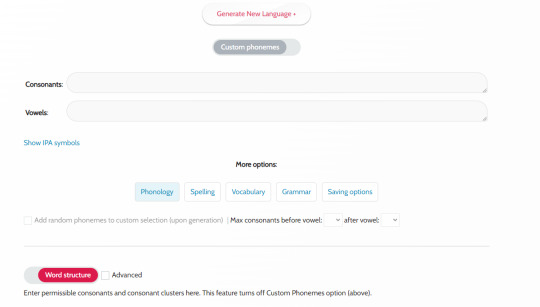
2
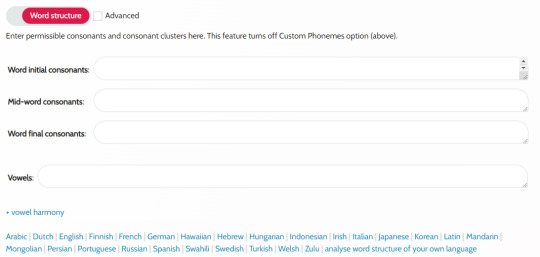
See those languages listed below? Click any. Let's go with English for starters.

What we need to do is copy some of those groups of letters and paste them into the Tab 2.
3
Now hit Generate on top of the page in Tab 2.
In this case we have a combo of English initials, Finnish medials, Hungarian finals and Korean vowels.
a /a/ v. gain, earn, reap
appa /ˈapːa/ n. note
bad /bad/ n. cotton, cloth, fabric, textile
béé /bɛː/ n. net
bizt /bizt/ n. skin, crust, leather
blee /bleː/ n. climate, temperature
bloobb /bloːbb/ v. vomit
blǔǔ /blɯː/ n. silk, thread
břaa /bɹaː/ conj. while
břirsh /bɹirʃ/ n. assassin
břǔ /bɹɯ/ v. wonder
bǔkkeb /ˈbɯkːeb/ n. air, breeze
cha /ʧa/ n. health
che /ʧe/ n. interview
chiish /ʧiːʃ/ v. catch
chu /ʧu/ n. craft
chúú /ˈʧʌʌ/ n. moisture
daansh /daːnʃ/ v. complain
danni /ˈdanːi/ n. goat
deerka /ˈdeːrka/ n. wolf
dhaaǰ /ðaːɟ/ n. item
dhék /ðɛk/ prep. including
dhizt wǔg /ðizt wɯg/ n. geography
dhonhǔ /ˈðonhɯ/ n. cat
dhǔlléǰ /ˈðɯlːɛɟ/ v. report, notify, inform
dillúshú /ˈdilːʌʃʌ/ n. truth
dot /dot/ n. toy
dřasht /dɹaʃt/ adj. real, authentic
dři /dɹi/ n. condition (requirement, stipulation)
dřoog /dɹoːg/ v. open
dřuuz /dɹuːz/ v. tear, rip
dúll /dʌll/ n. plot
dǔǔsh /dɯːʃ/ adv. not
e /e/ adj. big, great (very large), huge, massive, enormous
eǰ /eɟ/ n. crystal, prism
fahdéétoo wopsúnsh /ˈfahdɛːtoː ˈwopsʌnʃ/ n. barbecue
fez /fez/ v. miss (not hit)
flalv̌o /ˈflalʋo/ n. rod, shaft, bar, axle
flish /fliʃ/ n. potion, elixir
fo /fo/ n. tea
forto /ˈforto/ n. altitude
fřee /fɹeː/ n. store, shop, business
fřom /fɹom/ n. harbor, port
fřúlǰalt /ˈfɹʌlɟalt/ v. recognize
fud /fud/ n. style, fashion
fuumarts /ˈfuːmarʦ/ adj. smart, intelligent, clever
gag /gag/ n. dirt
gééshsh /gɛːʃʃ/ n. key
gi /gi/ v. like
glaa /glaː/ adv. ever
gli /gli/ num. thousand
glov̌uv̌o /ˈgloʋuʋo/ adj. tall
glup /glup/ n. acid
gooz ward /goːz ward/ n. cafe
gřalduǰ /ˈgɹalduɟ/ n. worker, employee
gřeent /gɹeːnt/ v. bake
gřilv̌ǔ /ˈgɹilʋɯ/ n. chance, odds, luck
gřoo /gɹoː/ v. dream
gřún /gɹʌn/ prep. before
gřǔǔ /gɹɯː/ n. dog
gú /gʌ/ n. friend
halt /halt/ n. meal, feast
héú /ˈhɛʌ/ n. fun
hooo /ˈhooː/ n. perception
hǔl /hɯl/ n. factory, mill, laboratory
hwansh /ʍanʃ/ n. shit
hwom /ʍom/ n. shape, structure, system
hwǔǔbb /ʍɯːbb/ n. pepper
jat /ʤat/ n. anxiety
ji /ʤi/ n. table, counter (flat, elevated surface), plateau
jú /ʤʌ/ n. planet
ka /ka/ n. fat (bodily substance)
kapsét /ˈkapsɛt/ n. map, menu
ke /ke/ n. change
kera /ˈkera/ adj. sad
kigoo /ˈkigoː/ n. behavior
kiryoog /ˈkirjoːg/ n. seed, grain, cereal
klants /klanʦ/ n. guess
klesu /ˈklesu/ v. flirt
klú /klʌ/ v. watch, look, monitor, peer, study, examine
kom /kom/ n. mass
křaay /kɹaːj/ n. game
křil /kɹil/ n. needle
křǔnts /kɹɯnʦ/ n. row
kúhtu /ˈkʌhtu/ n. support
kutt juny /kutt ʤuɲ/ n. souvenir
kǔǔrt /kɯːrt/ adj. aroused (sexually)
kwalch /kwalʧ/ v. meet
kwo /kwo/ n. muscle
kwútt /kwʌtt/ prep. with (accompanied by)
lap /lap/ n. valley
léryo /ˈlɛrjo/ adj. good, appropriate, hot (attractive), nice, moral
lolméé /ˈlolmɛː/ n. harmony
loongoo /ˈloːngoː/ n. protection
lǔǔ /lɯː/ n. chest
mal /mal/ v. shock, startle, stun, surprise
mé /mɛ/ n. stitch
méttuǰ /ˈmɛttuɟ/ n. lawyer
moorhaa /ˈmoːrhaː/ n. parcel, package, bundle
munt /munt/ v. follow
mǔǔtúrts /ˈmɯːtʌrʦ/ adj. possible
nantúk /ˈnantʌk/ v. listen
né /nɛ/ n. rate
nerduǰ /ˈnerduɟ/ n. gardener
noo /noː/ n. mud, cement
nualt /ˈnualt/ v. record
nuuz /nuːz/ n. sport
ot /ot/ v. cure
pak /pak/ n. train
pimistany /ˈpimistaɲ/ v. keep (store), store
plall /plall/ v. serve
plég /plɛg/ prep. to, towards
plǔ /plɯ/ n. cup, mug
pot /pot/ n. strategy (plan), tactic
přéy /pɹɛj/ v. drive, ride, steer
přoǰ /pɹoɟ/ n. visit
přunts /pɹunʦ/ adj. empty, vacant, naked, nude, tired (needing rest)
puǰ /puɟ/ n. vendor
pǔǔ /pɯː/ v. might
řaa /ɹaː/ n. corpse, carcass
řéé /ɹɛː/ v. grab, clutch, grip
řiilla /ˈɹiːlːa/ adj. best
řimppi /ˈɹimpːi/ v. chase
řitú /ˈɹitʌ/ n. difference
řoooo /ˈɹoːoː/ n. victory
řun /ɹun/ v. improve
sa /sa/ pron. nothing
sap /sap/ v. hang, dangle
seemmoolǰ /ˈseːmːoːlɟ/ adj. plain
shaa /ʃaː/ n. cell (room in a prison)
she /ʃe/ v. remember
sheposko /ˈʃeposko/ n. daughter
short /ʃort/ prep. down
shřezoo /ˈʃɹezoː/ n. discovery
shřo dřa /ʃɹo dɹa/ n. dagger
shřuu /ʃɹuː/ n. alcohol, liquor
shuu /ʃuː/ adj. light (weight), fragile
skaa /skaː/ n. dress, costume
skéétt /skɛːtt/ n. wife
skovoov̌ú /ˈskovoːʋʌ/ adj. broken
skřo /skɹo/ v. smell (emit odor), stink
skúmmo /ˈskʌmːo/ n. uncle
skwat /skwat/ det. every, each
skwoosh /skwoːʃ/ n. bill, check
sléélǰ /slɛːlɟ/ n. letter (of an alphabet)
slony /sloɲ/ v. doubt
slúppu /ˈslʌpːu/ n. hint
sméé kwú /smɛː kwʌ/ n. candle
sminch /sminʧ/ num. six
smú /smʌ/ n. party
sna thaab /sna θaːb/ n. drought
snee /sneː/ v. bend, fold
snont /snont/ n. doll
snuu /snuː/ n. committee
sony /soɲ/ n. crime
sot /sot/ n. dialect
spe /spe/ v. lie
spild /spild/ n. money, wage
splanaǰ /ˈsplanaɟ/ adj. personal
splu /splu/ n. crown
spřaǰ /spɹaɟ/ adj. cultural
spřoo /spɹoː/ n. ass
spú /spʌ/ n. test
ste /ste/ v. steal, rob, snatch
steshshod /ˈsteʃʃod/ adv. usually
sto /sto/ prep. like
střad /stɹad/ adv. well
střilch /stɹilʧ/ v. drop
střǔ /stɹɯ/ v. rise
stuyt /stujt/ adj. quiet, silent, subtle, elusive
sǔn /sɯn/ n. message, note
sǔǔl /sɯːl/ conj. than
súyt /sʌjt/ n. sheep
swi /swi/ n. belly
swúǰ /swʌɟ/ adj. economic
taa /taː/ v. miss (long for)
tash /taʃ/ n. bug
téyt /tɛjt/ adj. awful, terrible
thall /thall/ n. ash
thay /thaj/ n. orgasm
théyt /thɛjt/ adj. famous
thish /θiʃ/ n. sign, signal, symptom
thoo kuy /thoː kuj/ n. middle class
thřét /θɹɛt/ v. deserve
thřooskoo /ˈθɹoːskoː/ n. bottle
thul /θul/ n. trunk (large box)
tii /tiː/ n. east
toosht /toːʃt/ n. vagina
třapuu /ˈtɹapuː/ v. stop, halt
třilan /ˈtɹilan/ n. security
třooalt /ˈtɹoːalt/ v. lose
tu /tu/ n. will
tushsh /tuʃʃ/ n. strap
twaasúl /ˈtwaːsʌl/ n. machine
twe /twe/ adv. also, as well
twǔ /twɯ/ conj. either
ǔny /ɯɲ/ num. nine
uushsh /uːʃʃ/ n. victim
vartoov̌úod /ˈvartoːˌʋʌod/ adv. finally
viipunoo /ˈviːpunoː/ adj. skilled
voor /voːr/ n. success, benefit, profit
vǔrt /vɯrt/ v. drown, drench, suffocate
wanuu /ˈwanuː/ n. effort
wi /wi/ adv. maybe, perhaps
wishǔrsh /ˈwiʃɯrʃ/ n. library
woo /woː/ pron. everybody
wǔguǰ /ˈwɯguɟ/ n. scientist
wuult /wuːlt/ n. fool
yeed /jeːd/ n. prostitute
yolch /jolʧ/ adj. available
yuudúz /ˈjuːdʌz/ v. leave (let remain), let
Definetly not like English - already good for a foreign language if you ask me.
Now, let's transfer those rules to Awkwords.
1
Open an alphabetic text sorter. Set custom separator to "/"

Put all of the categories (initials, medials, finals and vowels) through the sorter and paste the results (separately) into the Awkwords site.
2
Set the syllable structure to (C)V(KV)(N), enable duplicate filter and press Generate.

3
You can then sort all of this alphabetically, again, with the separation being linebreaks

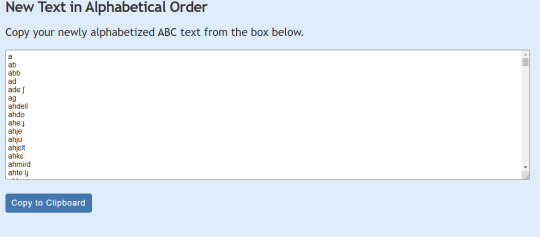
And honestly? If you already know IPA, you can read all of these rather easily. Here you go, boom - a dictionary. Not speaking of the one we already generated on Vulgarlang.
Afterwards if you wanna get spicy, take your output and go to the Procedural Name Generator site.
1
Paste your output into the Current Data field.
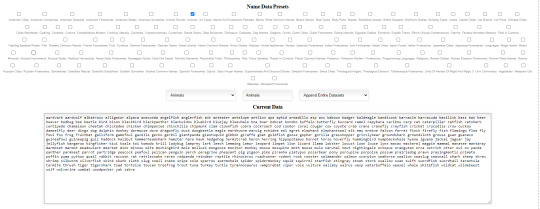
2
In result, you get words that are following the rules of your protoconlang and thus can be used further later. Though the unneeded capitalization might be annoying, you can always visit the Convertcase site.
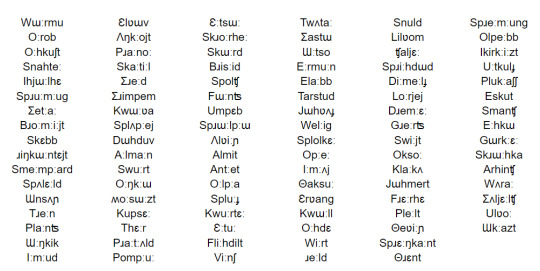
#conlang#conlanging#writing#constructed language#worldbuilding#creative writing#natlang#artlang#worldbuilding tips#tutorial
34 notes
·
View notes